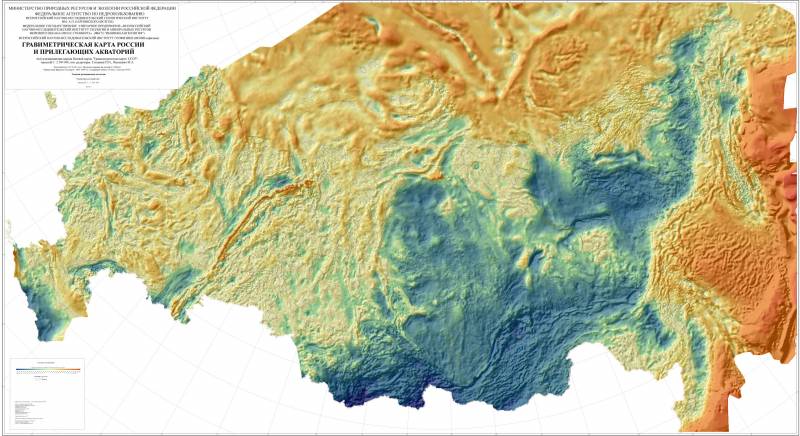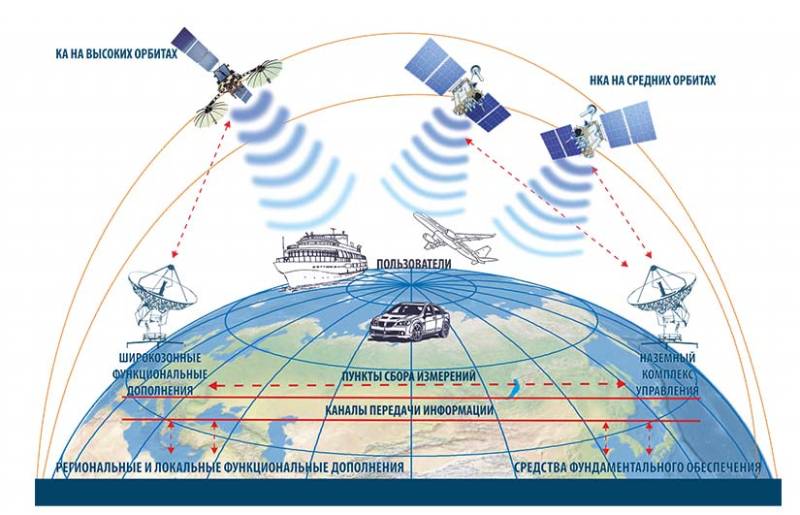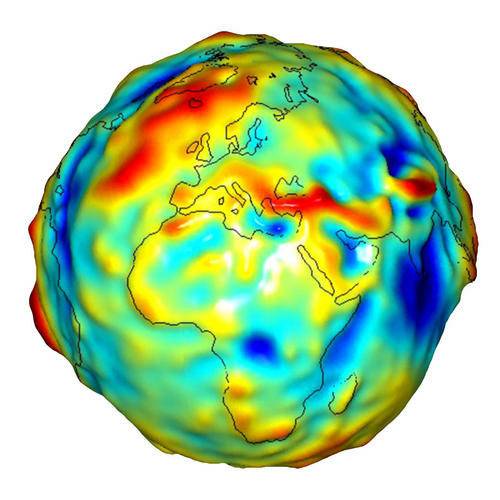Gravity navigation as an instrument of the future

Gravimetric map of Russia and surrounding territories on a scale of 1: 2 500 000. VSEGEI them. A.P. Karpinsky, 2016 / vsegei.com
Several types of navigation systems exist and are widely used, differing in operating principles and measurement accuracy. In the future, a fundamentally new system may be put into operation that calculates the coordinates according to the features of the Earth's gravitational field (GPZ). It is expected that this method of determining the location will be particularly accurate - and at the same time high complexity.
Promising direction
The presence of a developed space group and the improvement of all basic technologies opens up new opportunities for world science. In particular, the presence of high-precision instruments for measuring the physical fields of the planet and objects on its surface makes it possible to compile detailed models of various kinds suitable for use in various fields.
Over the past few years, research has been conducted in our country and abroad in the direction of the so-called gravitational navigation systems. Necessary work is carried out and new data is being collected, processed for further use. The basic principles of the new navigation system have already been identified, and the process of its creation continues.
In Russia, several organizations are working in this direction. In particular, the All-Russian Research Institute of Physicotechnical and Radio Engineering Measurements (VNIIFTRI) from Rosstandart is engaged in the creation of techniques for collecting data and processing incoming information about the gas processing plant in order to create new navigation aids.

The principles of operation of the GLONASS satellite system. The complex is critically dependent on radio communications, which leads to risks. Graphics IAC KVNO / glonass-iac.ru
Recent reports on the topic of gravitational navigation appeared the other day. The Zvezda weekly, with reference to the leadership of Rosstandart, wrote about the continuation of work on a promising project and the receipt of new results. They also recalled the benefits of new technologies and their applications.
Measurement and calculation
The concept of gravitational navigation is based on the fact that the GEA parameters at different points on the planet's surface (or above it) are slightly different. Earth is not an ideal ball or ellipsoid; its surface has a complex relief, and the thickness of the earth's crust is composed of different materials. All this affects the parameters of gravity on and near the surface. Often, the actual values differ from the calculated values for a given point, which is called the gravitational anomaly. In addition, due to a number of factors, different centrifugal forces are observed at different points.
The concept provides for the measurement of the GPZ parameters and centrifugal force at different points with further processing. The resulting gravimetric map can be entered into the memory of navigation equipment and used in calculations. Based on the data on the GEA, correction of the inertial or satellite navigation systems is possible. In this case, the total error of the entire complex is reduced to centimeters. In addition, the ANN with correction according to the GPZ data is characterized by the highest noise immunity.
Observations show that the GPZ is a fairly reliable "standard" for navigation systems. The rate of change of the gravitational field is much lower than that of the magnetic field, and the GPZ data can be used for decades without a noticeable loss in calculation accuracy. However, earthquakes and other processes can change the state of the gas processing plant and require updating maps.
Practical measures
According to recent reports, Russian scientists - like their foreign colleagues - have been collecting data, searching for gravitational anomalies and compiling gravimetric maps for more than a year. Special equipment on board aircraft and satellites measures the values of fields in a huge number of points and transmits them to ground-based computing centers. The result of this work is a map that can provide high accuracy navigation.

The GLONASS spacecraft of various modifications. Graphics IAC KVNO / glonass-iac.ru
The development of navigation equipment capable of using new maps and interacting with other equipment is also being carried out. However, as far as we know, such projects have not yet led to the appearance of products suitable for actual use.
The introduction of new principles of navigation may be hindered by the lack of accurate maps of a significant part of the earth’s surface. In fact, at the moment, navigation through the gas processing plant in practice does not give special advantages over ANNs or satellite systems. The situation can only change in the future when all the necessary research and design work is completed.
Applications
New principles of navigation can find application in various fields where particularly precise determination of coordinates, independence from external signal sources, and other specific features is required. First of all, this is military affairs. The appearance of gravitational navigation systems suitable for operation will increase the combat effectiveness of a wide range of models of equipment and weapons.
The military may be interested in both increased accuracy in calculating coordinates and unique noise immunity. In fact, the only way to influence such systems is to artificially change the GPP — which requires tremendous efforts or is not possible at all.
A high-precision guided missile, using a gravimetric map, can more accurately follow a given route and hit a target with known coordinates with a smaller deviation. Such principles can be used by both cruise missiles and ballistic missiles. However, such an operation will require an accurate and up-to-date map of the gas processing plant on the route, which imposes special requirements for reconnaissance and organization of the strike.

Gravitational anomalies on the surface of the Earth according to the NASA GRACE mission. Graphics by NASA / earthobservatory.nasa.gov
New principles of navigation are of great interest to science. With their help, it is possible to carry out more accurate binding, which is useful in various studies in a number of areas. The accuracy of data collection is improved, and this can become the basis for new important discoveries.
We should not forget about civil and commercial transport. Under normal circumstances, ships or aircraft have sufficient navigation aids, but in some situations more accurate systems may be required. It is possible that the emergence of full-fledged efficient means of navigation through the GPP will interest aircraft and shipbuilders, as well as commercial carriers.
Waiting for success
According to recent reports, VNIIFTRI is now busy compiling accurate gravimetric maps of different areas suitable for further use in practice. Data on the GPZ parameters and the observed forces are processed and converted into a form convenient for use. The development of navigation equipment for implementation in practice is also ongoing.
Both of these components of the new direction are distinguished by high complexity, duration and labor. Unfortunately, even the approximate dates for introducing new technologies into practice remain unknown. In addition, the actual prospects of such developments from the point of view of application in various fields are unclear. Nevertheless, work is ongoing, and real results should be expected in the future. If new technologies reach the application and live up to expectations, a radical change will occur in a number of areas.
Information